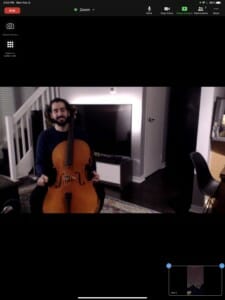Great work this week! Please see attached picture for your reference of excellent cello posture.
C major 1 octave
- make sure thumb stays under the 2nd finger
- raise left arm for lower strings
- add the 2nd octave
- keep working with a C drone – can use one on youtube
G major 1 octave
- when we say lower, we mean pitch wise. move your hand towards the scroll
- keep working with a drone
D major 1 octave
Music theory: understanding sharps. The order of sharps FCGDAEB (father charles goes down and ends battle). The key name will be the note above the last sharp.
- D major has two sharps
- try not to slant the fingers. keep them rounded
- 3 and 4 are close together. Try to think of having the 3rd finger higher
- use our ear to find pitches. try not to look at your left hand before or while you are playing.
Bow exercises
2nd finger will go on the metal piece. All the other fingers will naturall fall on the bow, straight and relaxed. pinky will be next to the other fingers, not on top of the wood. Thumb will be opposite the 2nd finger,bent and relaxed, not flexed.
- point the tip/point of the bow upwards
- tap the fingers alternating 1, 2, 3, 4, then 1+4, 2+3, 1+3, 2+4
- now turn the tip on its side and do the same exercise, all the while keeping the same bow hold and keeping the fingers relaxed
Twinkle
- Don’t let your fingers slant
- good intonation! :)
- practice in front of a mirror, watching the left hand to made sure the fingers stay rounded and in the correct position
- drop left arm for A string. Think about the wrist – Are you flexing the wrist to push down the string or using arm weight?
French Folk Song
- Practice singing first, listen to recordings online if you are struggling to remember the tune
- try to start without looking at your left hand
- in D major – 2 sharps
- practice with a D drone
- practice in front of a mirror to make sure the left arm is in the right position
- make sure the thumb is bent and relaxed through the whole
Open bowed strings
- practice bowing open strings: Start with just A and D
- use your bridge as a reference for the correct bow angle
- on the A string, the tip will turn towards you, and the frog will point away
- When you pull the bow (doing a down bow) the elbow will start in at the cello, then it will raise up as the arm expands and the bow travels to the tip on the string.When you push the bow (an up bow) the opposite will happen. bringing the elbow back into the cello as you move to the frog
- make sure the bow stays in the middle lane: halfway between teh end of the fingerboard and the bridge

